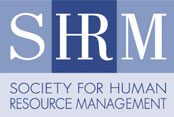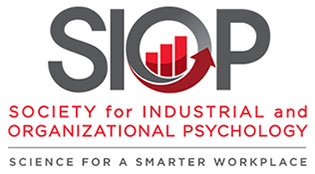
 SIOP and SHRM: Promoting Evidence-Based HR
SIOP and SHRM: Promoting Evidence-Based HR
A collaboration between the Society for Industrial and Organizational Psychology (SIOP) and the Society for Human Resource Management (SHRM).
To further the use and understanding of evidence-based HR practices, SIOP and SHRM have partnered to create a series of resources for HR practitioners. These resources, available to both SIOP and SHRM members, are specifically intended to infuse the science of industrial-organizational (I-O) psychology and other HR disciplines into management practices for daily use in the workplace.
SHRM-SIOP White Paper Series
The SHRM-SIOP Science of HR white paper series provides practitioner-oriented reviews of evidence-based HR practices. These papers, written by leading researchers and practitioners in the field of I-O psychology and HR, make the science of evidence-based HR practices accessible to SHRM members.
For more information regarding the SHRM-SIOP Science of HR Series, please contact: Samuel Robinson (Samuel.Robinson@shrm.org) or David Dubin (David@dubinadvisorygroup.com).
SIOP is continuously working to develop materials about topics that will be published and distributed by SHRM to its membership. Each collaborative article will be posted here and can also be viewed on SHRM's website here.
- Data Visualization: Get Visual to Drive HR's Impact and Influence
Data visualization is an immensely powerful technique for exploring and communicating information. To a degree far beyond traditional text or number-based formats, well-designed visualizations make data accessible, clear, enticing and engaging to business audiences. Yet, despite the recent surge in visualization’s use, many HR professionals aren’t proficient in these compelling approaches. This paper provides an overview of key data visualization concepts; reviews the evidence base supporting the use of data visualization; and recommends a set of practical data visualization resources.
- Trends and Practices in Talent Analytics - October 2017
Increasingly, organizations are investing in or upgrading their efforts in talent analytics. Based on 22 interviews with academics, consultants and practitioners at 16 corporations and other talent analytics experts, this paper offers a review of key approaches, competencies and tools. Examples of sophisticated talent analytics projects to address human resource challenges and organizational dynamics are also provided. We find that successful talent analytics depends on mandates, structure and operationalization, and responses to obstacles. By classifying talent analytics work into three broad categories—data infrastructure and reporting, advanced analytics, and organizational research—we offer a high-level roadmap for building and growing the talent analytics function.
- The Bigger Picture of Employee Well-Being: Its Role for Individuals, Families and Societies - April 2017
A wealth of literature from industrial/organizational psychology and other fields indicates that the well-being of employees influences various individual job outcomes (e.g., attendance and productivity) and non-work outcomes (e.g., disease and mortality). This white paper summarizes these results but also goes beyond them, highlighting less well-known findings. We show that employee well-being has broader impacts such as on the school performance of children of working parents and on the American economy as a whole. Moreover, we discuss that work, when organized and managed in certain ways, can produce various positive individual and societal benefits. The paper closes with a discussion of how governmental and organizational policies can promote well-being and, in turn, bring about these gains.
- Understanding Nonstandard Work Arrangements: Using Research to Inform Practice - March 2017
This paper provides a literature review on nonstandard work arrangements with a goal of answering four key questions: (1) what are nonstandard work arrangements and how prevalent are they; (2) why do organizations have these arrangements; (3) what challenges do organizations that adopt these work arrangements face; and (4) how can organizations deal with these challenges?
Nonstandard workers tend to be defined as those who are associated with organizations for a limited duration of time (e.g., temporary workers), work at a distance from the organization (e.g., remote workers) or are administratively distant from the organization (e.g., third-party contract workers). Organizations use these kinds of workers to minimize costs, increase flexibility or take advantage of technology. However, there are unanticipated costs associated with these work arrangements. These costs stem from the challenge of managing the social exchange between workers and the organization, coordination of work and social integration in the workplace, and employee identification with the organization. We suggest some actions that organizations need to take when employing nonstandard workers.
- Evidence-Based Strategies to Improve Workplace Decisions: Small Steps, Big Effects - August 2016
Although the need for effective decision-making is ubiquitous in the workplace, in practice the failure rate of important workplace decisions is surprisingly high. This white paper discusses evidence-based strategies that can be used to improve the quality of workplace decisions in today’s data-rich but time-poor environment. We emphasize strategies that are applicable across a wide variety of workplace decisions and that are relatively simple to execute (in some cases, requiring just a few minutes). We also respond to potential objections to the use of structured decision strategies. We end with a pre-decision checklist for important decisions.
- Conducting Background Checks for Employee Selection - August 2016
Background investigations are used by 86% of organizations in the U.S. to determine if applicants have previously engaged in behaviors that suggest they might engage in future counterproductive behaviors on the job or be a threat to the safety of others. A background investigation might consider some or all of the following: reference checks, credit history, criminal record, driving record, work history, military service, education and personal references. This paper will discuss legal considerations in using two of the most controversial components of the background check: criminal history and credit history.
- Optimizing Perceived Organizational Support to Enhance Employee Engagement - June 2016
Developing and maintaining an engaged workforce remains a critical objective for HR professionals as domestic and foreign competition stiffens. Perceived organizational support (POS), involving the extent to which employees feel the organization values their work contributions and cares for their well-being, provides an important tool for this objective. Evidence-based research consistently shows that POS is linked to employees’ increased psychological well-being and performance plus reduced absenteeism and turnover. We provide HR professionals, upper-level managers and frontline supervisors with tactics to enhance POS and its benefits for employees and their work organizations.
- Strategies for Engaging and Retaining Mature Workers - January 2016
The aging of the labor force promises dramatic shifts in workforce demographics that have implications for human resource (HR) science and practice. The looming retirement of the Baby Boom generation, seemingly en masse over the next decade in industrialized countries, will leave many organizations with vacancies that will be difficult to fill with younger, less experienced workers. The imperative for organizations faced with such an exodus in talent is to understand how best to retain and engage mature workers. Yet, relatively few organizations report developing strategies to prepare for these demographic shifts. This paper provides a review of current research on workforce aging relevant for engaging and retaining mature workers. Specific topics include job performance, age-related changes in abilities and motivation, and considerations for training. Strategies presented highlight the importance of developing organizational policies that engage—and benefit—workers of all ages.
- Implementing Effective Cyber Security Training for End Users of Computer Networks - September 2015
Cyber security is a concern for all modern organizations. These organizations cannot achieve their cyber security goals through hardware and information technology (IT) workers alone, so all employees who use computer networks must be trained on the knowledge, skills and policies related to cyber security. This paper reviews what is known about effective cyber security training for end users of computer systems and offers suggestions about how human resource (HR) leaders can effectively implement this training.
- Coaching for Professional Development - June 2015 Coaching can be an effective and integral component of leadership development programs. Popular among human resource professionals and clients, coaching facilitates leaders’ professional growth and helps to build a powerful team—from executives to first-line managers and team leaders. Coaching has a proven track record of success, and many studies have shown how coaching enhances decision-making skills, improves interpersonal effectiveness and increases confidence. The maturing workforce necessitates thoughtful succession planning, and coaching is often a strategic element of this effort. Integrating coaching into an organization’s culture will ensure the longevity and sustained value of the program.
- New Talent Strategy: Attract, Process, Educate, Empower, Engage and Retain the Best - May 2015 In reaction to the dramatic changes the millennial culture is bringing to the workplace and the coincidence of dramatic business disruptions that are driving the need for more innovative employees, human resource departments are changing their existing approaches to talent acquisition and retention based on the new strategic realities.
- Competency Modeling Documentation - March 2015 This white paper examines why documentation should be considered an essential element of all competency modeling projects and provides a documentation framework that adheres to professional and regulatory guidelines.
- Social Science Strategies for Managing Diversity: Industrial and Organizational Opportunities to Enhance Inclusion January 2015
This paper presents two individual-level strategies that facilitate inclusion and the benefits of diversity: psychosocial support and confrontation.
- Putting the "Performance" Back in Performance Management - January 2015
In this paper, the authors provide evidence-based, practical approaches for improving performance management.
- Leadership Development: Growing Talent Strategically - February 2014
A key challenge facing organizations today involves developing their current and aspiring leaders. In this paper, the authors highlight a number of strategies to address this challenge and increase the likelihood that leader development efforts will yield successful outcomes.
- The Evolution of Employee Opinion Surveys: The Voice of Employees as a Strategic Business Management Tool - September 2013
The goal of this white paper is to discuss the role of employee surveys as tactical events in business operations, and the importance of having broad-reaching plans following the surveys' results in order to enact positive change.
- Applicant Reactions to Selection: HR's Best Practices - August 2012
This paper bridges the gap between research on job candidate attitudes and behavior and applied practice by highlighting why candidate reactions matter, outlining the key research findings, and sharing a list of best practices for human resource managers directly involved in employee selection.
- Achieving Well-Being in Retirement: What HR Professionals Need to Know - August 2012
This paper summarizes the research evidence and makes recommendations for policy makers and individuals to achieve well-being in retirement.
- Skill-Based Pay: HR's Role - June 2011
This paper provides a detailed discussion of its different forms and purposes.
- Driving Customer Satisfaction Through HR: Creating and Maintaining a Service Climate - February 2011 This paper presents data highlighting the link between service climate, customer satisfaction and human resource management.
Looking for more white papers? Check out the SIOP white paper series here!